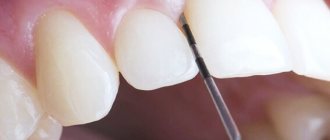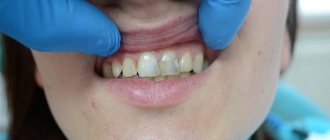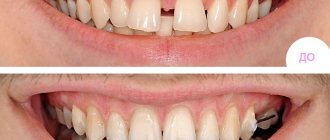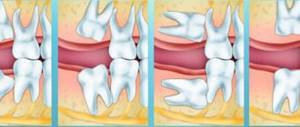Manifestations of the disease
The onset of the disease may be asymptomatic. Then the caries spreads deeper, symptoms appear:
- Sensitivity to irritants (sweet, sour, cold foods). The discomfort goes away immediately after eliminating these irritants. Since the painful sensations are short-lived, the patient is in no hurry to see a dentist. But it is important to pay attention to this and see a doctor.
- In bright light, a change in the color of the enamel on the side surfaces is noticeable: grayness of the tissues is noted. Darkened or black enamel is visible between the teeth.
- Regular food getting stuck between teeth. If previously food did not get stuck between the gaps, then with the appearance of caries the patient notices this symptom.
- Bad breath, taste in the mouth.
- Advanced stage: chips of the side walls are observed. Fragile infected walls cannot withstand the chewing load.
Pros and cons of dental implants
The dental implant procedure allows you to preserve the functionality and aesthetics of your teeth. But, like other types of surgery, it comes with some risks. Before deciding to install teeth using this method, we recommend that you consider all the pros and cons of the implant procedure.
Pros:
- high aesthetics; externally, dental implants are difficult to distinguish from natural crowns;
- preventing the amount of bone loss (atrophy);
- there are no restrictions on food consumption;
- do not cause problems with chewing;
- do not create discomfort for the patient;
- no food gets stuck under the implants, which eliminates the risk of proliferation of pathogenic microorganisms and the development of inflammatory processes;
- To attach the orthopedic structure, grinding of adjacent teeth is not required;
- standard oral hygiene (does not require special care);
- long service life, at least 10 years;
- Dental implants allow you to create a beautiful smile from an even row of snow-white teeth.
Minuses:
- there is a risk that the metal root will not take root in the bone tissue;
- a long rehabilitation period, during which some painful symptoms are noted;
- anesthesia is required.
As a rule, restoring lost teeth using implantation is not a cheap procedure, but it can effectively solve the aesthetic and functional problem of the dentition for many years. Insert dental implants in Moscow
possible on credit or in installments (a special offer for patients valid at the dental clinic).
What factors lead to caries
If you do not perform oral hygiene regularly, plaque and food particles remain on your teeth. Such conditions are favorable for infection: pathogenic bacteria begin to develop. Their life process is associated with the release of acid. This acid destroys the enamel, forming a cavity.
The main cause of caries is insufficient oral hygiene, when plaque remains on the teeth. To clean plaque, a toothbrush alone is not enough: you need dental floss.
There are several theories why caries occurs and what it is connected with:
- Place of residence. Research shows that people in the United States suffer from more tooth decay than people in Nigeria. It is associated with the characteristics of the water composition and the presence of certain microelements.
- Profession. People who work in confectionery shops are more likely to suffer from tooth decay. The same applies to people whose work involves alkalis and acids.
- Age feature. Children and adolescents are vulnerable to caries. Closer to 40 years of age, there is a decrease in the activity and pathogenicity of bacteria in the oral cavity, and the amount of caries decreases.
- Gender. According to research, women are more likely to suffer from tooth decay than men. This is associated with pregnancy, lactation, when the female body gives some of the beneficial microelements to the child, and with the fact that the female half of the population more often consumes sweet foods.
Also popular among rinses are:
- Hydrogen peroxide solutions, chlorhexidine;
- Infusion of nut leaves;
- Decoctions of sage, oak, chamomile;
- Black radish juice mixed with honey;
- Propolis tincture (20 drops per glass of water is enough)
- Shilajit infusion (3 g of raw material per half glass of water).
The downside of herbal rinses is the darkening of tooth enamel due to the settling of dyes on it.
Important! You should not rinse intensively after tooth extraction because you may rinse out the clot that has formed in the hole!
Therapeutic applications on the gums can be made from:
- Fresh aloe leaf, separating juice;
- Grated raw potatoes;
- A cotton pad soaked in sea buckthorn oil.
As you can see, the methods are quite original, but you can turn to them if you don’t have medications at hand such as gels “Cholisal”, “Metrogil-Denta”, “Parodontsid”, etc. These drugs (especially “Cholisal”) help reduce swelling, stop inflammation and pacify pain. Gels such as “Kalgel” and “Kamistad” do not have a pronounced anti-inflammatory effect, but contain an anesthetic that will numb the mucous membrane for a while.
Diagnostics
It is difficult to independently detect caries in contact surfaces. Sometimes you can notice a small spot between the teeth, which is visible through the tooth enamel.
Often, while treating the surface of one tooth, the dentist sees caries on the adjacent tooth. This clinical situation requires treatment of two teeth.
During an examination of the oral cavity, the doctor uses dental instruments: a probe, a mirror. The instruments help to see distant areas of the teeth in detail. In the early stages of the disease, it is impossible to detect caries using a mirror or probe. The presence of plaque, stones, and food debris on the surfaces of teeth also makes diagnosis difficult. In this case, professional cavity hygiene is recommended, followed by a re-examination. The presence of crowded teeth also hinders diagnosis.
Modern dentistry involves conducting diagnostics before making a diagnosis. Diagnosis of dental caries is carried out using additional methods:
- X-ray. In order to determine whether there is a disease or not, an x-ray is taken using a radiovisiograph. The resulting image shows the structure of the tooth: enamel, dentin. If there is caries, it will look like a dark spot.
- CT scan. One of the types of X-ray diagnostics. This 3D visualization of all teeth helps to examine the jaw structures from all sides and make an accurate diagnosis.
- Diagnodent device. Helps to recognize carious cavities. The action of this wireless device is based on pulsed light waves. They are reflected from the surface of the enamel. When the device detects caries, a sound signal is emitted.
A complete diagnosis allows you to determine the diagnosis and select appropriate treatment. An experienced specialist only needs examination and radiography data to decide on treatment tactics.
What are the complications if caries is not treated?
If this disease is not treated, it spreads deeper, affecting more tissue. The final result: caries reaches the nerve (pulp), pain occurs. A serious inflammatory process begins. It is better not to cause pain, but to come to the dentist as soon as you notice the first symptoms of caries.
Consequences of non-treatment:
- Pulpitis is inflammation of the nerve. Characterized by acute pain. It is necessary to remove nerves and fill root canals. Treatment is longer and more expensive. Asymptomatic nerve inflammation occurs. The patient makes no complaints, but based on the diagnostic results, a diagnosis of chronic pulpitis is made.
- Delete. When a tooth is severely damaged, it cannot be saved. You need to have a tooth removed in Moscow.
- Chronic infection. Sometimes the patient does not experience acute pain, but numerous dental caries are the source of chronic infection, which, along with food and saliva, enters the body. This can lead to serious organ dysfunction.
- Spread of infection. If a person passes by the dentist’s office for a long time, the infection spreads beyond the root of the tooth and enters the periosteum, bone, and soft tissue. Then surgical intervention in a maxillofacial hospital and antibiotic therapy are required.
All of these complications arise due to untreated caries. Therefore, it is recommended to visit the dentist once every six months for a preventive examination. In addition, you should carry out professional oral hygiene twice a year and regularly maintain hygiene at home. Only regular observation, examinations, and diagnostics can eliminate caries in the early stages and prevent the development of complications.
What are the dangers of dental implantation?
Dental implantation is a full-fledged surgical procedure that has some risks of complications. Comprehensive preparation of the patient, studying his personal history and the correct choice of procedure helps to minimize the likelihood of developing unpleasant consequences of implantation.
The main risks of dental implantation:
1. Development of the inflammatory process in soft tissues. The reason for this consequence may be an infection introduced during the procedure due to non-compliance with hygiene requirements.
2. Re-implantitis – failure of a metal rod into the skull bone. To eliminate such a complication, an experienced doctor inserts the implant at a certain angle of inclination.
3. Intolerance to anesthesia. In this case, it is important to take into account the patient’s individual history and select the correct anesthesia medication.
4. Dehiscence of surgical sutures is exclusively a medical error.
5. The occurrence of swelling and minor bleeding after the procedure. An absolutely normal reaction observed in the first few days after implantation. As a rule, painful signs disappear on their own within 3-4 days.
6. Allergic reaction to titanium. Biological incompatibility with this metal is observed only in 2-3% of patients.
Negative consequences of implantation can occur due to non-compliance with specialist recommendations or due to medical error. To eliminate such risks, it is recommended to responsibly carry out all the appointments of the treating doctor during the rehabilitation period and, of course, to carry out dental implantation only in trusted dental centers, where highly qualified specialists with good experience in performing the implantation procedure work.
Prevention
Following a few recommendations will help you maintain a healthy smile for many years. These recommendations include:
- Regular proper hygiene. Brush your teeth at least twice a day. After eating, you need to rinse your mouth or chew chewing gum for 5-10 minutes. Use dental floss to clean the interdental spaces. Be sure to brush your teeth before going to bed.
- Reduce the number of snacks. Frequent meals lead to the fact that a favorable environment for the development of microorganisms is constantly created in the mouth.
- Reduce intake of carbohydrates, sugars: chocolate, caramel, flour products. Remaining food particles provoke the growth of bacteria.
- Carry out professional oral hygiene once every six months. This will remove dense plaque, stones and reduce the risk of caries.
- Contact your dentist promptly. If you experience pain or discomfort, you should not postpone visiting the dental clinic. It is better to treat the disease at an early stage, without waiting for complications to arise.
The disease is easier to prevent than to treat. By following simple recommendations, you can forget about dental treatment forever!










